Stuart Hwy Part 5 and final focuses on the township of
Katherine as
well as five other sites,
Manbulloo Airstrip and
Manbulloo Abattoir, McDonald
Airstrip, No 86 Station Hospital and Fenton
Airstrip .
Katherine marks the Southern extent of the Japanese bombing raids on the Northern Territory; on 22 March 1942, nine Japanese aircraft attacked the township. Dorothy Hall, in a letter,recounted: "The Japanese planes came over about dinner time, circled and left -most of the folk went down to the back of the river - they came back about a quarter of an hour later and let us have it .

Katherine Main St
They dropped two bombs near the store, one in a heap of rocks,where they killed a native called Roger....one near the hospital, the aerodrome and two near
Manbulloo. There were no planes on the aerodrome and except for Roger and a lot of holes, they didn't do any damage."
Manbulloo Airfield was developed as an alternative to extending
Katherine Aerodrome. Work commenced on 28 April 1942 by personnel of the US 43rd Engineer Regiment who completed the tasks by hand under difficult and trying conditions. Some later work was completed by the US 808th Engineer Battalion, and the Allied Works Council was responsible for sealing the runway and taxiways The airfield played host to a number of units including No 2 Air
Ambulance Unit, No 1 Repair and Salvage Unit,‘Doc‘ Fenton‘s No 6 Communications Unit and the American 380th Bombardment Group‘s 529th and 531st Squadrons equipped with B-24 Liberators.

Manbullo Airstrip Info sign
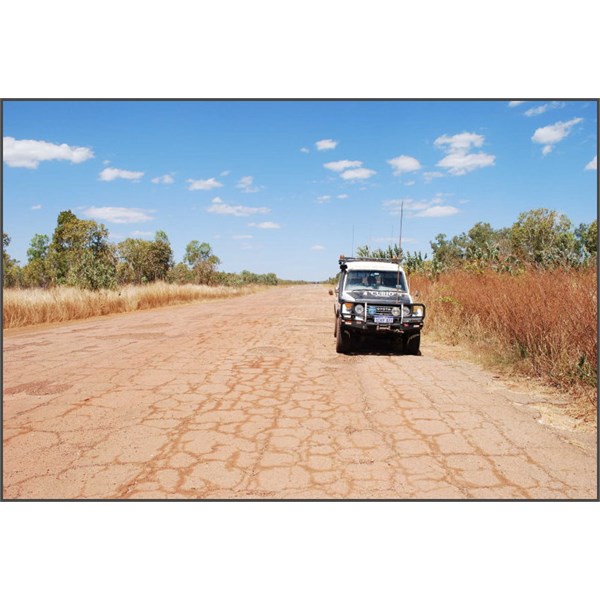
Manbullo Airstrip 2010
The Americans moved from the airfield on 1October 1943 to Long Airfield; it was not a popular transfer as the
Katherine iceworks, Australian nurses of 101 Australian General Hospital and the nearby
swimming hole more than compensated for the primitive living conditions. A proposal to upgrade
Manbulloo Airfield was put forward in mid-1944 but did not proceed as the airfield at Carson (or Tindal as it was better known) was almost complete.
Manbulloo‘s operational use ended in July 1944, when the RAAF's No 24 Squadron, equipped with B -24 Liberators, moved to Fenton Airfield.
The abattoir site was located off the Victoria Highway, 14km West of the
Katherine turn-off and is currently a part of
Manbulloo Station. Wartime relics remain intact at this extremely interesting site, displaying the wartime building techniques for the provisioning centres for the Armed Forces.
With the arrival in
Darwin of an Army garrison, the
Darwin Mobile Force in 1939, the military purchased meat supplies from local outlets, mainly Koolpinyah. Following the initial Japanese raids, the Army was tasked to supply meat for the three
services. It was a difficult task, given the fact that frozen and chilled meat supplies from the South were difficult to procure. In response to this shortage,the Army placed local contracts with suppliers at
Pine Creek,
Mataranka and the North Australian Meat Company at
Manbulloo Station (part of the giant British beef supplier, Vesteys) during 1942. Construction of the abattoir and freezing chambers was started in 1942 and by late 1944 some 700 head a week were being processed. A letter to the Minister for the Interior on 31 January 1945 stated that "the abattoirs could dispose of 150 head of cattle a day and could hold in cold storage about 1000 carcases. Several field butchery platoons were stationed at
Manbulloo Abattoir, including the 2/ 3rd Australian Field Butchery Platoon, along with supporting units of cooks and quartermaster personnel. The meat was chilled then dispatched to units. Some 46 buildings were located on site, among them two mess huts used by the engineers servicing the complex, chilling rooms, barracks, messes and poultry yards.
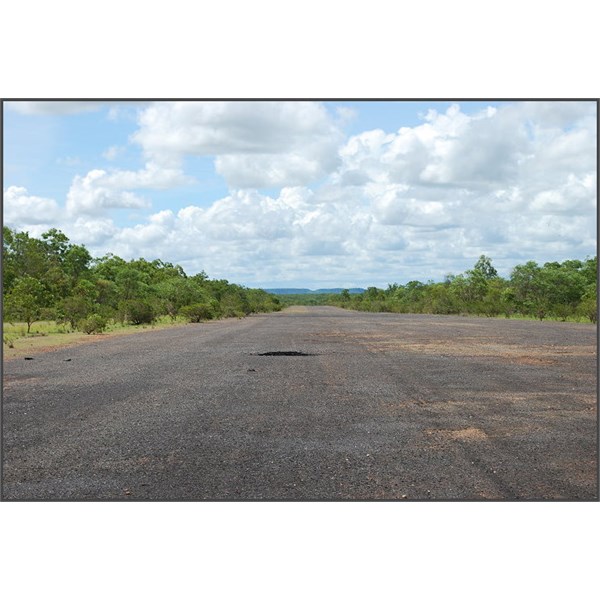
MacDonald Airstrip, from South End
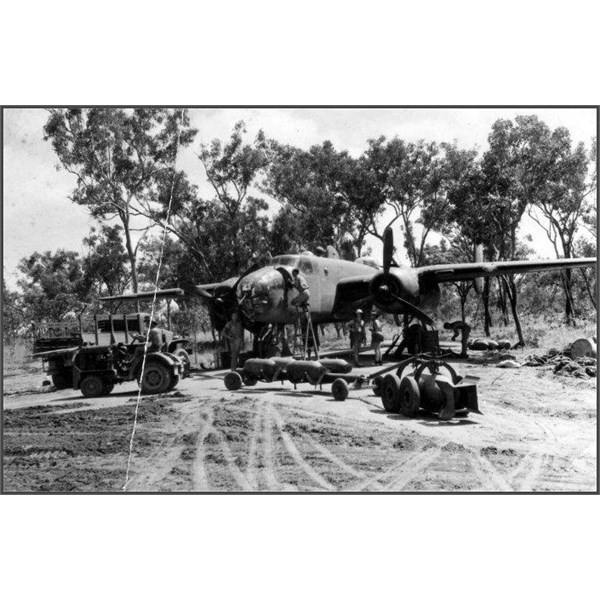
B-25 Mitchell at MacDonald airfield
McDonald airfield, proposed as part of the Aerodrome Development Programin early 1942, and dubbed' Burkholder by the Americans, was constructed initially by the US 43rd Service Engineer Regiment during March that year. Later works were carried out by the US 808th Engineer Battalion and the Allied Works Council (AWC). It was later named in honour of a No 13 Squadron Commanding Officer, Wing Commander JRG McDonald, killed at Laha on 10 December 1941.
The airfield was first occupied in November 1942 by No 54 Operational Base Unit, and No 1 Airfield Construction Squadron personnel completed works at the site in early 1943. On 18th January 1943 the first of No 18 N.E.l.-RAAF Squadron's B-25
Mitchell bombers arrived at the airfield. This unique unit's equipment and personnel a mixture of Dutch, Australian and Javanese arrived soon after and operations over the Netherlands East Indies began on 19 January; an armed reconnaissance was conducted over the Kai Islands. During the next four months, the unit flew some 60 missions over the NEl, although the location of the airfield necessitated refuelling and arming at the RAAF Station in
Darwin.
Accordingly, the unit moved North to
Batchelor in April-May of 1943 Apart from occasional aircraft, the airfield saw no further wartime activity although it was used as a communications field by theArmy for a time. The last recorded movement was a forced landing by a No54 (RAF) Squadron Spitfire A58-174 on 10th March 1944.
No 86 Station Hospital was located along a
sign posted track off Fountain Head Road, on the East of the Stuart Highway, the site has a scatter of concrete slabs on the sides of a prominent
hill. No 86 Station Hospital was established to service the USAAF bomber squadrons using Fenton, and later, Long Airfields. Under Commanding Officer Oliver E Ehrhardt, the unit comprised 12 officers (eight doctors, one dentist, three administrators), 15 nurses and 96 enlisted men. Personnel travelled overland from
Brisbane,while the nurses were flown to Fenton Airfield as accommodation became available, arriving on 13th August 1943. Development of the hospital site was under way by men of the 135th Medical Regiment's 'H' Company from nearby Fenton.
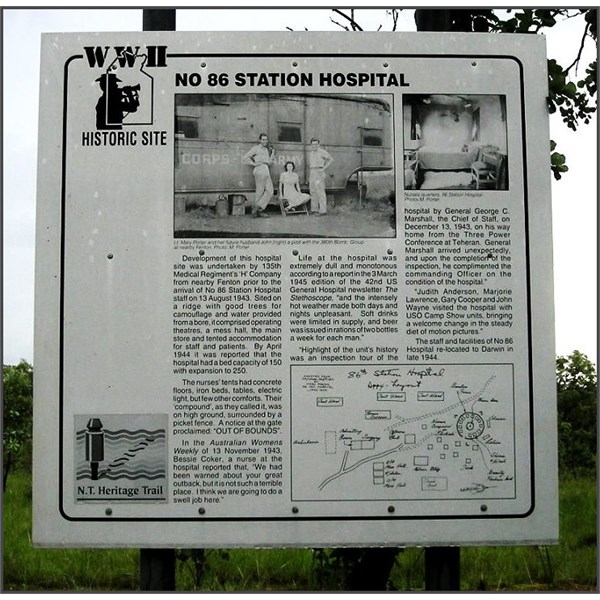
Info Sign - No 86 Station Hospital
Operating theatres, a mess hall and the main store were constructed of permanent material, while staff quarters and the wards were mainly tents. The hospital served the men of USAAF 380th Bombardment Group and provided a wide range of
services including X-ray and pathology.
The 380th Bombardment Group moved to
Darwin in late 1944. In mid-July No 86 Station Hospital was attached to the Far East Air Force and moved to Nightcliff north of
Darwin. With the arrival of RAAF bomber units at Fenton and Long Airfields, the site was then occupied by Nos 27 and 30 Medical
Clearing Stations. They provided medical
services until the deployment of the RAAF's No 82 Wing Liberator bombers to Morotai and Labuan in 1945
Fenton Airfield, situated along the Douglas Hot Springs road,13km South of the Stuart Highway turn-off, is one of the most complete wartime airfields. The track directly opposite the control tower site contains a graveyard‘ featuring American and Australian aircraft but not much is left now, scrap metal merchants cleaned most of the Aluminium out.
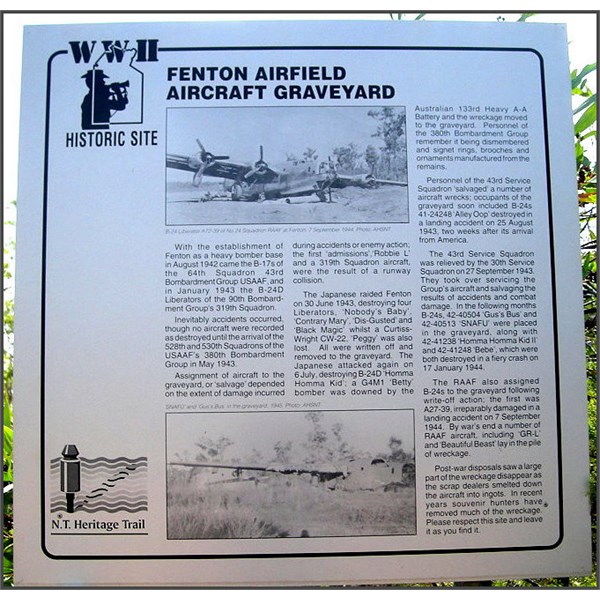
Fenton Graveyard Sign
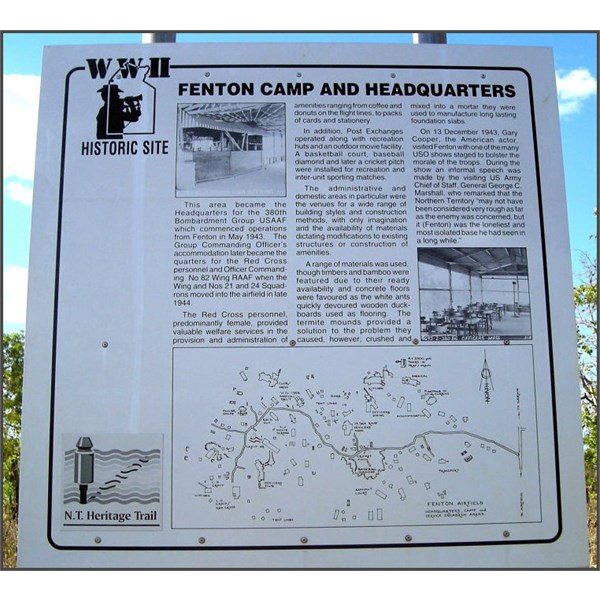
Fenton Camp Info Sign
The main
camp area is located 1 km north of the Fenton Airfield
sign. This is an extensive site and features many interesting relics, including Group Headquarters on top of the
hill, where signs marking return Visits by American servicemen can be seen. Fenton Airfield was named after the legendary 'Doc' Fenton of pre-war years. Construction of the airfield was begun by US 808th Engineer Battalion and later involved No 1 Airfield Construction Squadron and the Department of Main Roads (NSW). The airfield was occupied briefly by B-17 Fortresses of the 64th Squadron 43rd Bombardment Group USAAF in late 1942. In January 1943, the 319th Bombardment Squadron USAAF arrived with B-24 Liberators and began reconnaissance and strike missions against Timor, Celebes and the Moluccas. Australian occupation began in March with the arrival of 309 Radar Station and 149th Light Anti-Aircraft Battery.
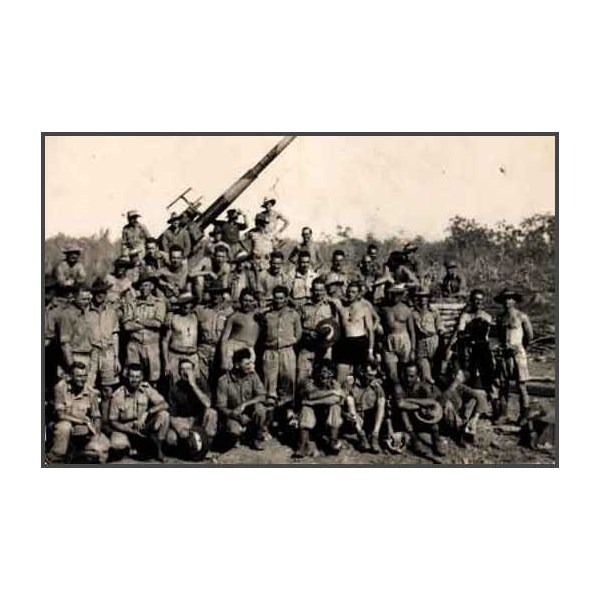
133rd Heavy Anti Aircraft Battery at Fenton
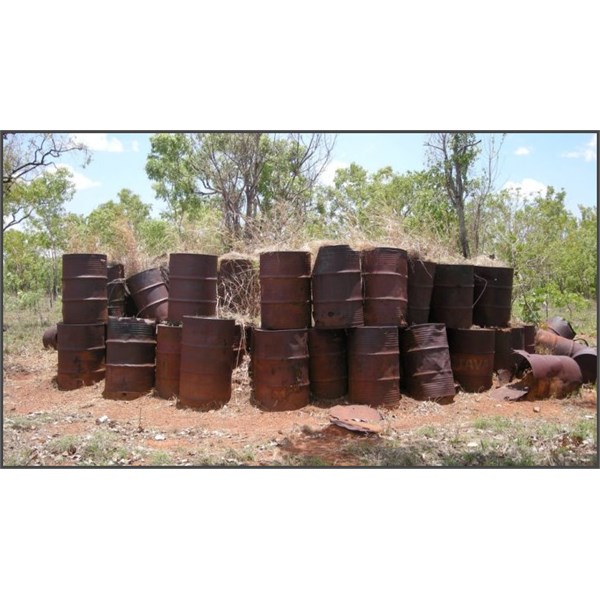
3.7 Inch Mobile Anti Aircraft Gun Emplacement , Fenton
The 133rd Heavy Anti-Aircraft Battery followed with its 3.7" guns The arrival of B-24s of the 528th and 530th Squadrons 380th Bombardment Group USAAF in May1943 attracted a number of support groups, including the 404th Quartermaster Company, 1006th Signals Company, 2051st Quartermaster Company, a Negro transport unit that achieved outstanding results, the 1535th Ordnance Company, and a team which provided fresh meat and bread daily from
Adelaide River. The first of a number of air raids on Fenton occurred on 30th June resulting in 27 Betty' bombers and 23 fighters being intercepted by Spitfire aircraft in which two pilots were killed. Two men were injured in the raid,while four Liberators were destroyed and much equipment was damaged.
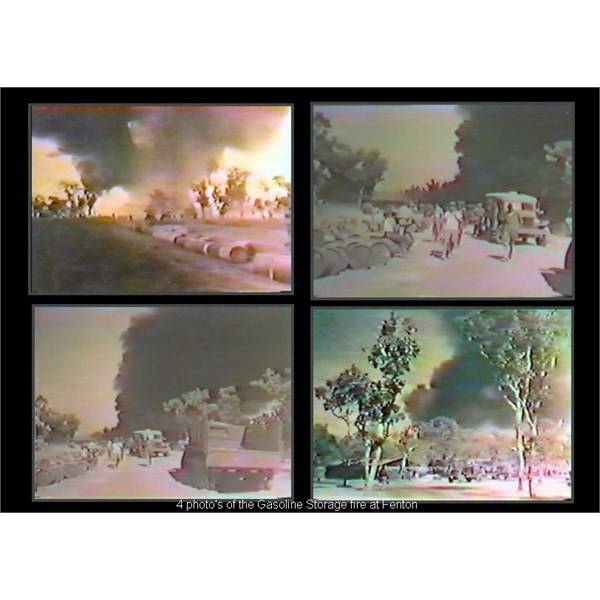
4 photo's of the Jap Air-Raid hit Gasoline Storage fire

380th BG revisit & Memorial at Fenton

Sgt Donald A Engel Memorial at Fenton

Medical van at Fenton
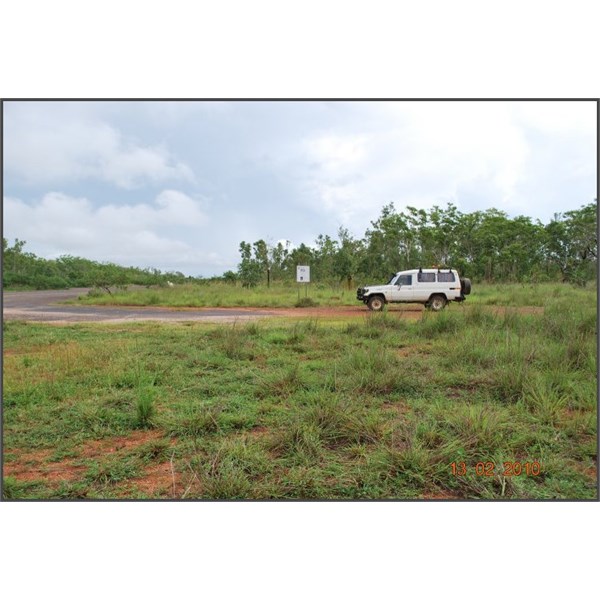
Not a Medical van at Fenton
A week later the Japanese attacked again, setting the fuel dumps aflame and damaging the runway. The Australian A-A crews succeeded in claiming one of the raiders. During1943-44,Liberators from Fenton continued to bomb targets including Balikpapan, Timor and the Celebes. The personnel and aircraft of the 380th Bombardment Group moved North to
Darwin in June and July 1944 ,followed by the attendant support units. The American presence was almost non-existent by August when the first RAAF units arrived.

Fenton Information
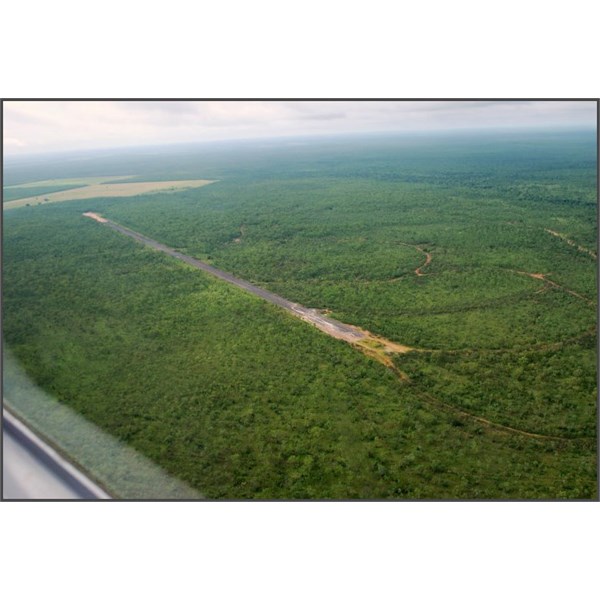
Fenton Airstrip from a Jabiru 120 , Feb' 2010
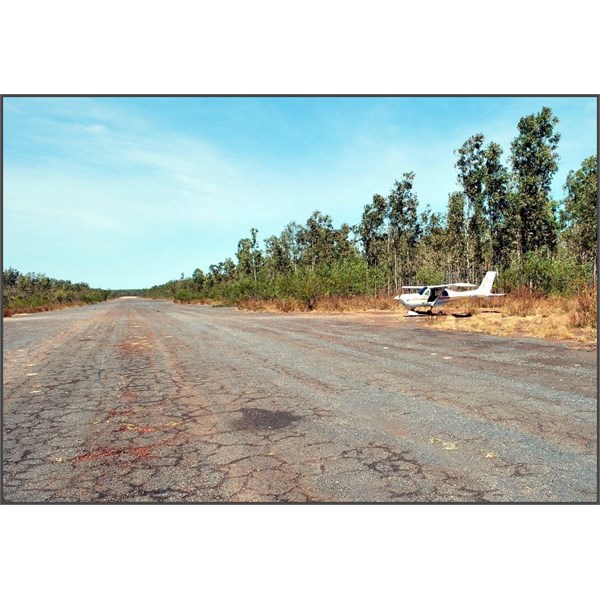
The Jabiru 120 on Fenton Feb' 2010
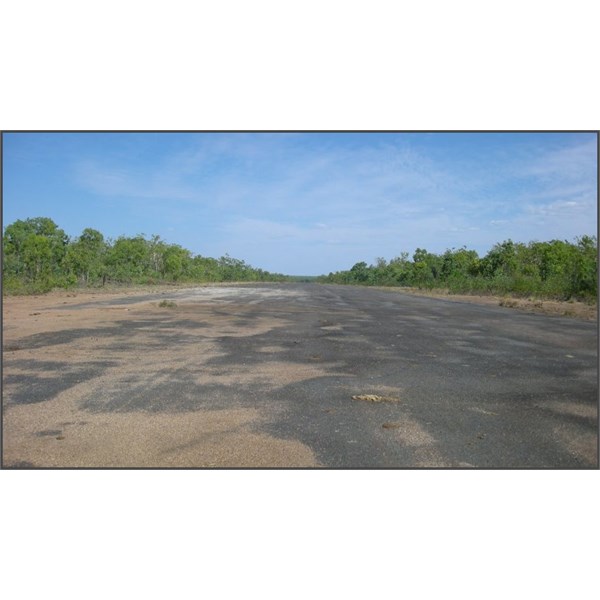
Fenton Airstrip NW End
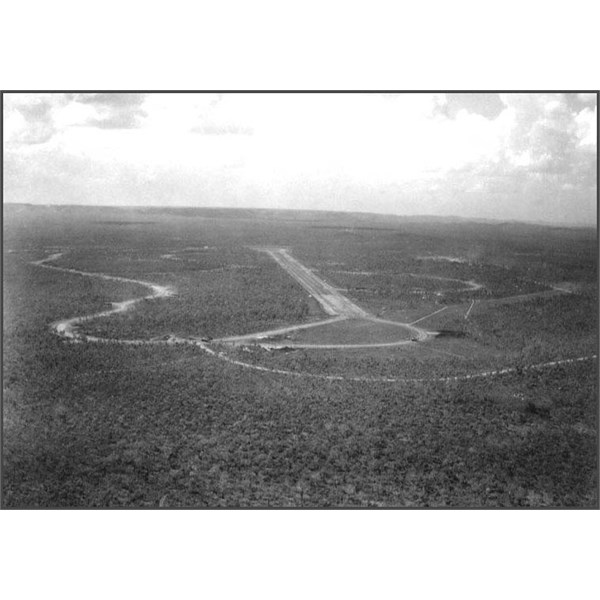
Fenton Field 1943
These included No 12 Replenishing Centre,No 11 Wireless Signals Unit and No 24 Airstores Park whose personnel established themselves at the facilities vacated by the Americans. Number 24 Squadron, HQ No 82 Wing and No 21 Squadron followed, equipped with the B-24 Liberators,and continued the tradition of long range missions. By 10th June 1945 all squadrons of the Wing had departed for
Darwin and the islands and, by November 1945 all but the caretaker units had left the airfield.
Maybe in the future I will cover the area between Fenton and
Darwin.
I wish you all a Happy New Year.
.